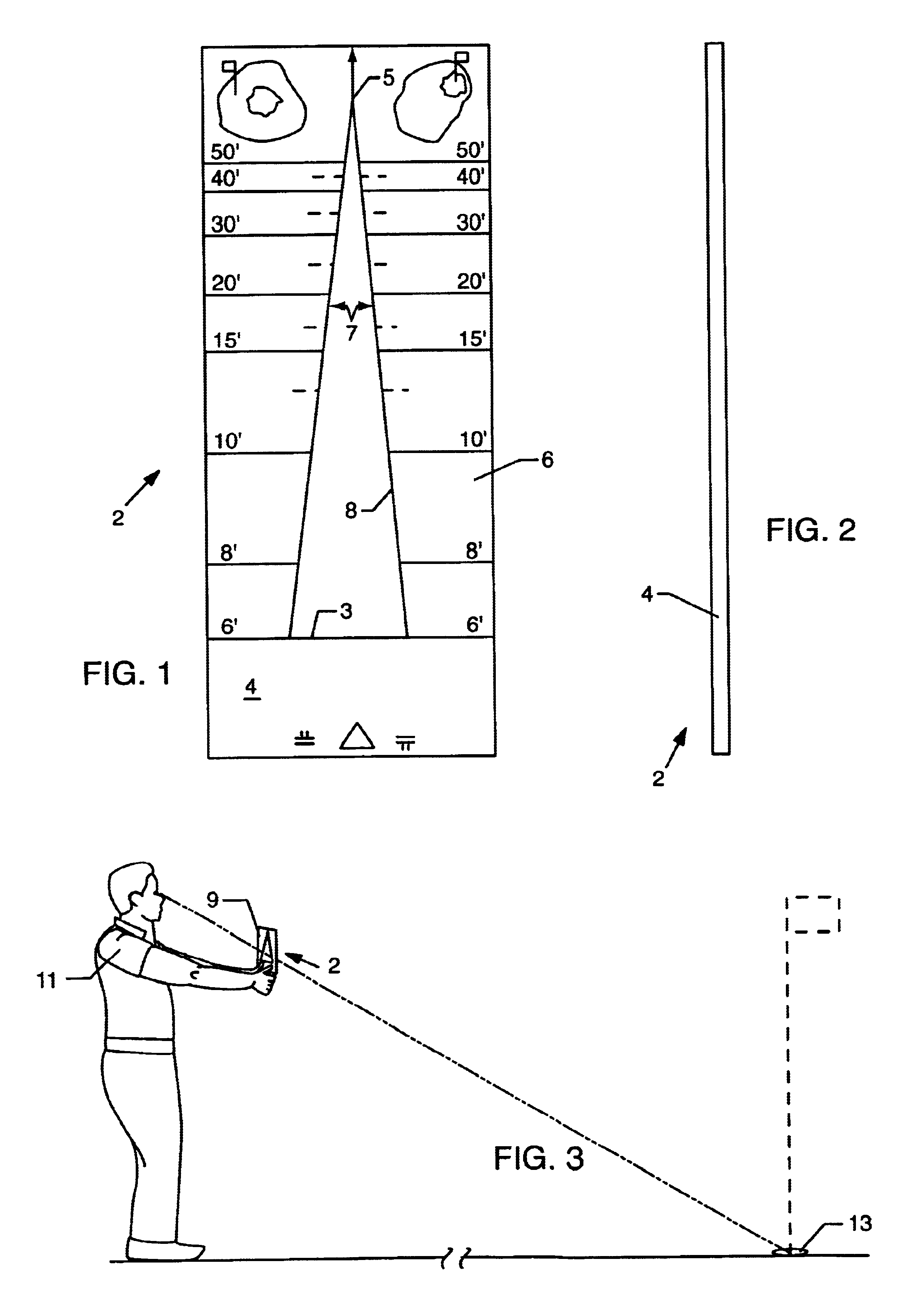Range finder
a range finder and range technology, applied in the field of range finders, can solve the problems of difficult to position the user or himself from a target, the useful device is more complicated for short-range distance determination, and the effectiveness of image-based range finders to date is quite limited, so as to achieve the effect of easy positioning the user or herself from a targ
- Summary
- Abstract
- Description
- Claims
- Application Information
AI Technical Summary
Benefits of technology
Problems solved by technology
Method used
Image
Examples
second embodiment
A second embodiment is a card member in accordance with the preferred embodiment but having an opening in the shape of a triangle other than in the general shape of an isosceles triangle.
(FIG. 4): A third embodiment, shown in FIG. 4, is a card member and triangle-shaped opening in accordance with the preferred embodiment that forms the cover of a golfer's scorecard. The cover is made of a clear plastic sheet and adapted to slip over a scorecard. By opening the cover, a golfer views the cup through the triangular opening. The range finder is then used as described above.
fourth embodiment
A fourth embodiment is a card member in accordance with the preferred embodiment having a triangular opening and, in addition, an arm positioned on one long side of the triangle and affixed in or to the card member. The arm is made to slide across the opening from one side and thereby narrow its dimensions. This allows the device to adjust, where appropriate, for use by persons of different heights and / or arm lengths while using the same markings.
(FIGS. 5 and 6): A fifth embodiment, as shown in FIGS. 5 and 6, is a range finder 2 in accordance with the preferred embodiment having a card-like member 4, where a first portion 6 is opaque and defines a generally triangular-shaped window 8 or opening through which a person can view an object. In addition, two movable arms 17, each positioned along each leg of the triangular-shaped opening and affixed to the top portion of the card member 4 by some fastening unit at a specified pivot point 16 on the back of the card-like member 4 or within...
sixth embodiment
A sixth embodiment is a first member having a v-shaped opening with a vertex having an included angle of between 5 degrees and 20 degrees but preferably 12 degrees. Lines and numerals are expressed on or adjacent to the edges or prongs of the opening. While this structure could be incorporated into innumerable devices, the following additional, exemplary embodiments are described as embodiments seven through ten:
(FIG. 7): A seventh embodiment of the invention is shown in FIG. 7 wherein a conventional golf glove has been modified to incorporate a range finder in accordance with this invention. As illustrated a golf glove 50 includes a back portion 51 which covers the back of a golfer's hand. The glove 50 also includes a tab portion 52 with a Velcro fastener or the like on one side thereof for snugly fastening the glove about the hand of a golfer in a customary manner. A palm portion (not shown) and back portion 51 are connected by seams and sections which correspond to the parts of t...
PUM
 Login to View More
Login to View More Abstract
Description
Claims
Application Information
 Login to View More
Login to View More - R&D
- Intellectual Property
- Life Sciences
- Materials
- Tech Scout
- Unparalleled Data Quality
- Higher Quality Content
- 60% Fewer Hallucinations
Browse by: Latest US Patents, China's latest patents, Technical Efficacy Thesaurus, Application Domain, Technology Topic, Popular Technical Reports.
© 2025 PatSnap. All rights reserved.Legal|Privacy policy|Modern Slavery Act Transparency Statement|Sitemap|About US| Contact US: help@patsnap.com



